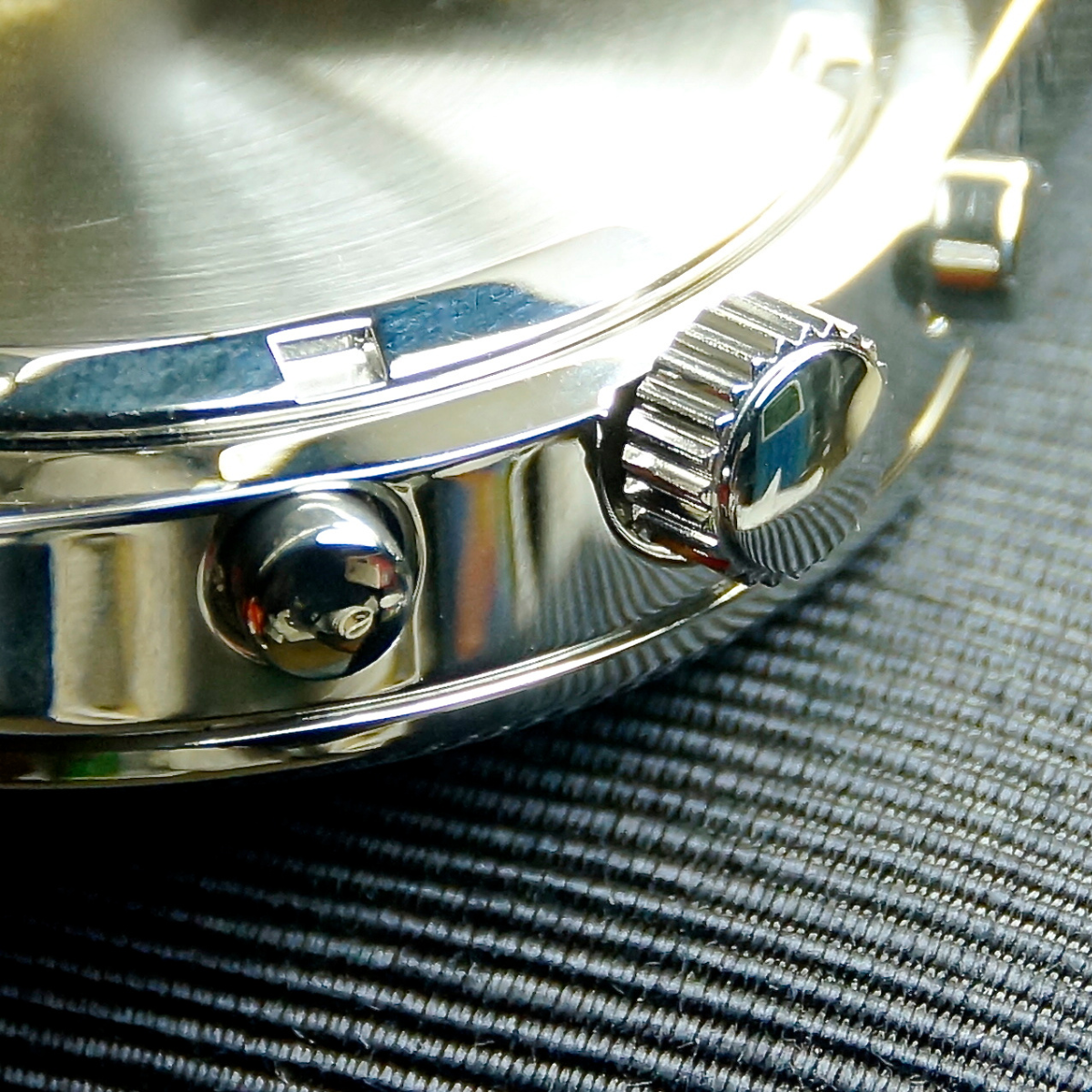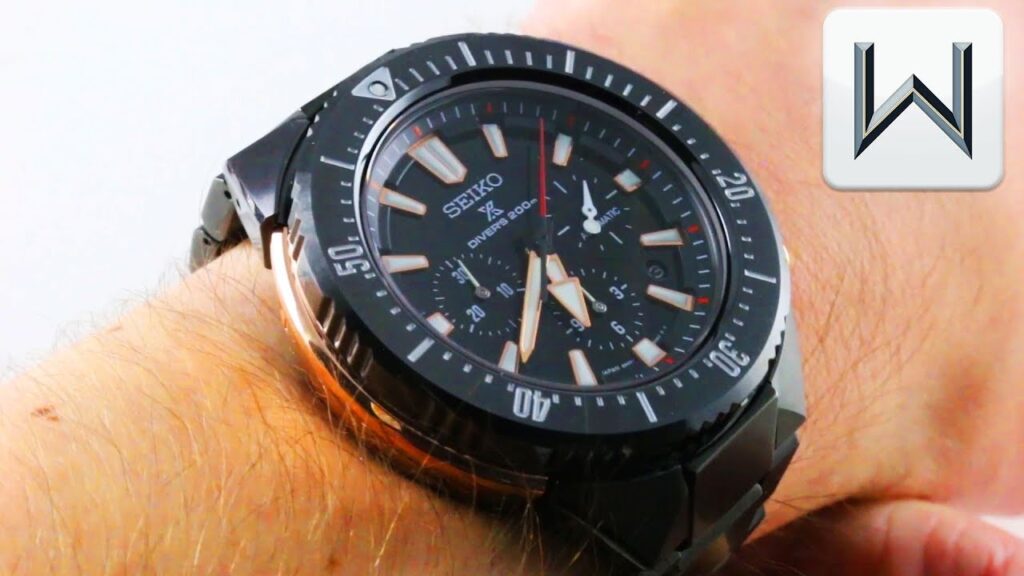
Introducing the Seiko Prospex Transocean Chronograph 200m SBEC002 Luxury Watch Review, brought to you by WatchBox Reviews. As a dive watch from Seiko, the world leader in sports watches, the Seiko Prospex 200m SBEC002 offers a combination of both style and functionality. With a sleek black stainless steel case and bracelet, this watch features a black dial and a folding buckle for added convenience. The SBEC002 includes various functions such as hours, minutes, small-seconds, date, a mono block ceramic dive bezel, and a chronograph. Boasting a thickness of 17mm and measuring 54.6mm from lug-to-lug, this luxury watch is a true statement piece. To get all the in-depth information, make sure to watch the full review. For the latest pre-owned luxury watch arrivals and unbeatable value in previously loved luxury timepieces, visit our website at www.thewatchbox.com.
Design
Case
The case of a watch is an important component of its overall design. It refers to the outer housing that not only protects the internal components, but also contributes to the aesthetics of the timepiece. When considering the design of a watch case, factors such as shape, material, and finish come into play. The shape of the case can vary from classic round to edgy square or rectangular designs. Materials commonly used for watch cases include stainless steel, titanium, and even precious metals like gold or platinum. The finish of the case can range from a high-polish shine to a brushed or matte texture, adding to the visual appeal.
Dial
The dial is the face of the watch, displaying the time and other additional information such as date or chronograph functions. It plays a crucial role in the overall design and legibility of the watch. The design of the dial can range from minimalistic and clean, featuring simple hour markers and hands, to more intricate designs with detailed patterns or complications. Additionally, the color scheme and choice of materials for the dial can greatly impact how the watch looks and feels on the wrist. Whether it’s a classic white or black dial, or a vibrant dial with colorful accents, the design of the dial is a key consideration for watch enthusiasts.
Bracelet
The bracelet of a watch is an integral part of its overall design, as it not only contributes to the aesthetics but also affects the comfort and fit of the timepiece on the wrist. A bracelet can be made from various materials, with stainless steel being the most common choice due to its durability and versatility. Other materials like leather or rubber may also be used, depending on the style and purpose of the watch. The design of the bracelet can range from simple and straightforward links to more intricate patterns or textures that add a touch of elegance or sportiness to the overall look. The choice of bracelet can greatly enhance the appeal of a watch, allowing it to be dressed up or down for different occasions.
Features
Timekeeping
Timekeeping is the primary function of a watch and one of the most important features to consider. A reliable and accurate timekeeping mechanism is essential for any watch. The movement inside the watch, whether it’s a mechanical or quartz movement, determines the accuracy and precision of timekeeping. Mechanical movements are often favored by watch connoisseurs for their craftsmanship and intricate engineering, while quartz movements are known for their precision and ease of maintenance. Additionally, features such as luminous hands and hour markers can enhance the legibility of the watch in various lighting conditions.
Dive Bezel
A dive bezel, also known as a rotating bezel, is a feature commonly found in diving watches. It is a ring that surrounds the dial and can be rotated in a single direction, usually counterclockwise. The main function of a dive bezel is to track elapsed time during dives, allowing divers to accurately measure their bottom time and decompression stops. The bezel is typically marked with minute indicators and often has a luminescent marker at the 12 o’clock position for easy reference. Apart from its practical use, a dive bezel can also add a sporty and rugged look to a watch, making it a desirable feature for many watch enthusiasts.
Chronograph
A chronograph is a popular complication found in many watches. It essentially adds a stopwatch function to the timekeeping capabilities of the watch. Chronograph watches have additional subdials on the main dial, typically for measuring seconds, minutes, and sometimes even hours. The chronograph function can be activated by pushers on the side of the watch, allowing the user to start, stop, and reset the stopwatch. This feature is not only practical for timing events or activities, but it also adds a level of functionality and versatility to a watch’s design.
Size and Dimensions
Case Thickness
The case thickness of a watch is an important consideration when it comes to comfort and overall wearability. It refers to the measurement of how thick or thin the case is from the front to the back. A slim and low-profile case can sit flush against the wrist, making it more comfortable to wear throughout the day. On the other hand, a thicker case may provide a more substantial and robust feel. The ideal case thickness varies depending on personal preference and the intended use of the watch. Dress watches tend to have thinner cases, while sports or dive watches may have thicker cases to accommodate additional features and water resistance.
Lug-to-Lug Distance
The lug-to-lug distance of a watch refers to the measurement from one end of the lugs to the other. Lugs are the protruding parts on the case where the bracelet or strap is attached. The lug-to-lug distance is an important factor to consider when determining if a watch will fit comfortably on your wrist. It helps determine how well the watch will sit on the wrist and whether it will have a balanced and proportional appearance. Watches with a shorter lug-to-lug distance are generally more versatile and can fit a wider range of wrist sizes. It is recommended to try on a watch or consult the specifications to ensure a proper fit before making a purchase.

Water Resistance
Water resistance is an essential feature to consider, especially for those who lead an active lifestyle or plan to wear their watch in water-related activities. The level of water resistance is measured in meters or atmospheres (ATM), indicating the depth to which the watch can be submerged without water damage. For example, a watch with a water resistance rating of 50 meters can withstand splashes or brief immersion in water, while a higher rating like 200 meters indicates that the watch is suitable for recreational diving. It is important to note that water resistance is not a permanent feature and can diminish over time due to wear and tear or improper handling, so regular maintenance and servicing are recommended to maintain the integrity of the watch’s water resistance.
Movement
The movement of a watch refers to the mechanism responsible for keeping time. There are two main types of movements: mechanical and quartz. Mechanical movements are often favored by watch enthusiasts for their craftsmanship and mechanical complexity. They rely on a network of gears, springs, and levers to power the watch and require periodic winding to maintain accuracy. Quartz movements, on the other hand, are powered by a battery and use an electronic oscillator to regulate timekeeping. They are known for their accuracy, reliability, and ease of maintenance, as they do not require manual winding. The choice between mechanical or quartz movement often comes down to personal preference and the desired level of involvement in maintaining the watch.
Durability
The durability of a watch is an important consideration, especially for those who lead an active or adventurous lifestyle. A well-built watch should be able to withstand daily wear and tear, as well as occasional bumps or knocks. Factors that contribute to the durability of a watch include the materials used, the construction techniques, and the quality of craftsmanship. Stainless steel is a commonly used material for watch cases and bracelets due to its durability and resistance to corrosion. Additionally, features such as scratch-resistant sapphire crystals and robust crown and pusher mechanisms can enhance the overall durability of a watch. It is advisable to choose a watch that is built to withstand the demands of your intended usage to ensure longevity and reliability.
Price and Value
The price and value of a watch are subjective and can vary greatly depending on factors such as brand reputation, materials used, craftsmanship, and additional features. It is important to consider the overall package that a watch offers and evaluate whether it aligns with your expectations and budget. While luxury watches with prestigious brand names often come with a higher price tag, there are also many affordable options available that offer great value for money. When assessing the price and value of a watch, it is worthwhile to consider its design, features, movement, and durability, as well as the after-sales service and warranty provided by the manufacturer.
Pros
- A well-designed watch can be a stylish accessory that complements your personal style.
- Additional features such as chronograph or dive bezel add functionality and versatility to a watch.
- Water resistance can provide peace of mind for those who engage in water-related activities.
- The choice between mechanical or quartz movement allows for personalized preferences in timekeeping.
- A durable watch can withstand daily wear and tear, ensuring longevity and reliability.
- A watch that offers good value for money can be a worthwhile investment.
Cons
- The price of some luxury watches may be cost-prohibitive for some individuals.
- Watches with extensive complications or intricate designs may require more careful maintenance and servicing.
- Water resistance can diminish over time, requiring regular maintenance to maintain its integrity.
- Mechanical movements require periodic winding, which may not be suitable for those seeking convenience.
- Some individuals may find certain watch sizes or dimensions uncomfortable or disproportionate on their wrists.
- The wide range of available options can make it challenging to choose a watch that meets all personal preferences and requirements.
Conclusion
When choosing a watch, it is important to consider various factors such as design, features, size, water resistance, movement, durability, price, and value. The case, dial, and bracelet contribute significantly to the overall design and aesthetics of a watch. Features such as timekeeping, dive bezel, and chronograph add functionality and versatility to a watch’s capabilities. The size and dimensions of a watch, including case thickness and lug-to-lug distance, should be carefully evaluated for a comfortable fit. Water resistance ensures that a watch can withstand water-related activities without damage. The movement type, whether mechanical or quartz, determines the timekeeping accuracy and level of involvement required in maintenance. Durability is crucial for a watch to withstand daily wear and tear, and the price and value should align with personal expectations and budget. Consider the pros and cons of each factor to make an informed decision and find a watch that suits your style and needs.

